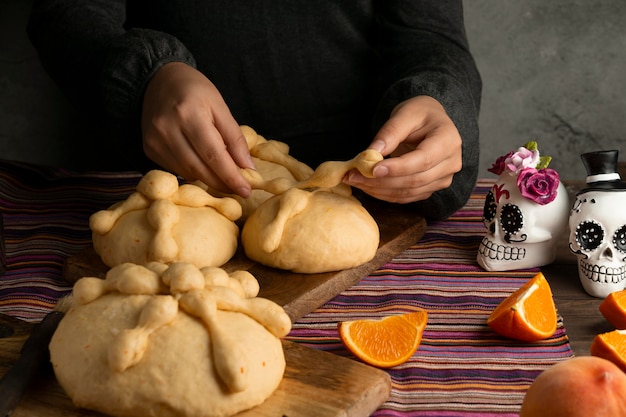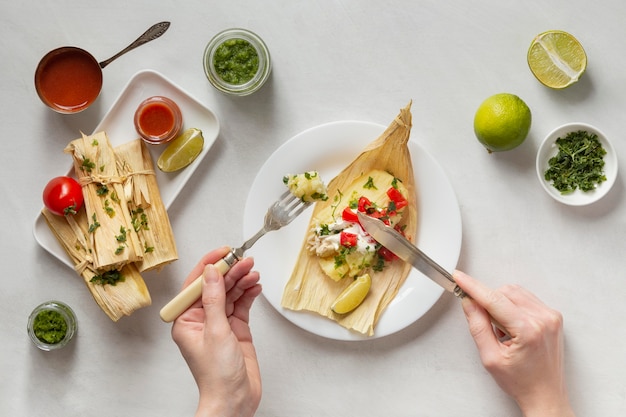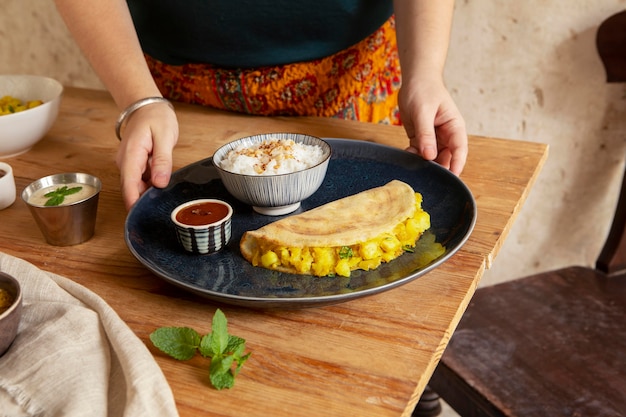Let's be honest, making tamales is a commitment. It's a journey that involves meticulous preparation, a touch of artistry, and a whole lot of patience. But oh, the reward! That first bite into a perfectly cooked tamale – the masa, soft and yielding, cradling a juicy, flavourful filling – it's pure bliss. And you know what? Achieving that perfect bite isn't rocket science, but it does require a bit of understanding about the nuances of cooking time. I've been making tamales for years, and I've learned that it's not just about the clock, it's about understanding the role of each stage in creating that magical tamale experience. So, grab your favourite mug of coffee, settle in, and let's embark on this tamale journey together.
(Part 1) Getting Started: A Primer on Tamale Cooking

First things first, let's clear the air: there's no single magic number when it comes to cooking time. It's a bit of a dance that involves a few key players.
(Part 1.1) The Tamale Tango: Understanding the Variables
Here's the deal: the perfect cooking time for your tamales depends on several factors, and understanding these factors is like having a cheat sheet for tamale success.
- The Size Matters: Just like a roast chicken, larger tamales need a little more time to cook through. It's all about ensuring that heat reaches the centre of the filling and cooks everything evenly. Think of those big, hearty tamales like marathon runners – they need a longer journey to reach the finish line.
- Your Steaming Powerhouse: Every steamer has its own personality. Some heat up faster and distribute steam more evenly than others. This can influence the overall cooking time. Just like different ovens have different temperatures, so too do different steamers have different strengths. It's all about knowing your equipment and adjusting accordingly.
- The Tamale Crowd: A smaller group of tamales will reach their peak faster than a large gathering. The more tamales you have, the more steam they'll need to share. It's a bit like a family dinner: the more people at the table, the longer the meal takes to prepare. But don’t worry, it’s a good kind of "long" – the kind filled with laughter and shared experiences.
- The Filling's Role: Some fillings, like those with lots of vegetables or a lot of moisture, might require a bit more time to reach their optimal texture. It’s like knowing when your favourite stew is ready – it’s not just about the clock, it’s about the way it looks and smells.
- Your Personal Touch: Some people prefer their masa slightly firmer, others love it super soft. This is your tamale world, and you’re the ruler! If you like your masa with a bit of bite, you might cook it a little longer. If you crave a melt-in-your-mouth experience, you might shorten the cooking time slightly.
Don’t be overwhelmed by all this information. It’s about understanding the key ingredients in your tamale journey so you can navigate the process with confidence.
(Part 2) Mastering the Masa: The Foundation of a Great Tamale

Think of the masa as the foundation of your tamale masterpiece. It's the canvas on which you'll paint a symphony of flavors. But just like a foundation needs to be sturdy, your masa needs the right consistency. It should be smooth, pliable, and not too dry or too wet. Too dry, and your tamales will be tough and crumbly. Too wet, and they’ll be mushy and disappointing.
(Part 2.1) The “Pinch Test”: Your Masa Whisperer
Here's a trick I've learned over the years: the "pinch test." Take a small amount of masa in your hand and gently squeeze it. If it holds its shape and doesn’t crumble, you’re good to go. If it falls apart, add a little water. If it’s too sticky, add a little more masa flour. This simple test will give you a clear picture of your masa's personality.
(Part 2.2) A Touch of Patience: The Secret Ingredient
Don't rush the masa mixing. Take your time and blend those ingredients until they're happy and harmonious. It’s like a good conversation: the more you talk, the better you understand each other. It’s worth the extra effort! I promise, you’ll taste the difference.
(Part 3) The Husk's Embrace: The Natural Wrapper

Now, let's talk about those corn husks. They’re more than just a container; they're the natural wrapper that adds a touch of rustic charm and helps create a moist, tender tamale. You want to choose husks that are pliable, free of any tears or holes. They’re like a warm hug for your tamale, protecting it as it cooks.
(Part 3.1) Soaking Secrets: A Hunk's Transformation
The first step is soaking. You need to give those husks a good soak in hot water for at least 30 minutes. I usually let them soak overnight if I have the time. It's like giving them a spa treatment, making them soft and manageable.
(Part 3.2) Trimming and Cleaning: A Neat and Tidy Hunk
Once the husks have softened, it's time for a little grooming. Trim them to the desired size, and remove any rough edges or debris. Think of it as giving your tamale a beautiful, natural outfit.
(Part 3.3) Removing the Dry Layer: A Final Touch
You'll also want to remove that thin, dry, paper-like layer from the husk. It's usually on the top or bottom side. It’s like removing a layer of makeup – revealing the husk's true beauty and ensuring it's ready to embrace your tamale.
Remember, well-prepared husks will prevent your tamales from drying out during cooking and will also give your tamales a beautiful, natural wrapper. It’s a win-win!
(Part 4) Filling Your Tamales: A World of Flavour
Ah, the filling – this is where the fun really begins! This is your chance to unleash your inner culinary artist and create flavour combinations that will make your taste buds sing. From traditional chicken and pork to vegetarian options like black beans and cheese, the possibilities are endless. I have a soft spot for the classic pork filling with a hint of cumin and oregano – it's a taste of nostalgia that takes me back to my childhood. But the beauty of tamales is that they welcome experimentation.
(Part 4.1) Cooking the Filling: Safety First, Flavor Second
Now, here's a crucial point: make sure your filling is cooked thoroughly before assembling your tamales. Undercooked filling can lead to foodborne illness, so it’s essential to take this step seriously. Meat should be cooked to an internal temperature of at least 165°F (74°C) and vegetables should be tender. You can always pre-cook your filling separately before assembling the tamales.
I've been known to experiment with different flavours and combinations. I recently discovered the joy of making tamales with a slow-cooked barbacoa filling. It’s a real treat!
(Part 5) Mastering the Assembly: Building Your Tamale Parcels
Now comes the moment of truth: the assembly process. It's a bit like putting together a miniature work of art. Here's how I do it:
- The Masa Layer: A Smooth Foundation: Take a corn husk and spread a thin layer of masa evenly across the bottom half. Leave a little space at the top for folding. Think of it as creating a beautiful, soft bed for your filling.
- The Filling Centerpiece: A Generous Touch: Place a generous spoonful of your filling in the centre of the masa. I like to use about a tablespoon per tamale. It's all about balance!
- The Fold and Roll: A Culinary Embrace: Fold the sides of the husk over the filling and then roll up the tamale like a burrito. It's a graceful dance of hands, ensuring the filling stays safely tucked inside.
- The Secure Knot: A Final Touch of Elegance: Use the excess husk to tie the ends of the tamale closed. It's like adding a ribbon to a gift – a finishing touch that keeps everything together.
- Steam-Friendly Placement: Arrange the tamales in your steamer, making sure they are standing upright and not touching each other. It's like giving them their own little space to relax and cook happily.
(Part 6) The Big Reveal: Cooking Your Tamales
Alright, the stage is set, and it's time for the grand finale – the cooking process! You have two main options: the traditional steaming method or the modern-day instant pot approach. Both methods have their own unique charm and advantages.
(Part 6.1) Steaming: The Classic Method
Steaming is the tried-and-true method, known for producing tender, flavorful tamales. It's like giving your tamales a luxurious spa treatment – slow and steady, allowing the flavours to develop and the masa to reach its perfect texture.
- The Steam Bath: If you're using a stovetop steamer, fill the pot with about an inch of water, bring it to a boil, then reduce the heat to a simmer. Place your tamales in the steamer basket and cover the pot. It’s all about creating a beautiful, moist environment for your tamales to thrive.
- The "Done" Test: Steam your tamales for about 2-3 hours, or until the masa is cooked through and the filling is heated. Here’s a quick way to check if they’re done. Gently peel back a corner of a husk. The masa should be cooked through and pull away easily from the husk.
(Part 6.2) The Instant Pot: A Modern Twist
For those of us who live in a world of time constraints, the Instant Pot offers a modern-day shortcut to tamale bliss. It's fast, efficient, and incredibly convenient. It’s like having a personal tamale chef at your fingertips.
- Instant Pot Setup: Add about a cup of water to the bottom of the Instant Pot, place your steamer basket inside, and arrange your tamales in the basket. Close the lid and set the valve to seal.
- pressure cooker Power: Cook on high pressure for 30 minutes. It's like a burst of flavour and a quick way to achieve those tender, delicious results.
- The Natural Release: After cooking, allow the pressure to release naturally for about 10 minutes before releasing the remaining pressure manually. The tamales will be cooked through and ready to eat.
(Part 7) The Art of Timing: Deciphering the Tamale Clock
Now, let's break down the cooking time a bit more, giving you a clear picture of how long your tamales need to bask in the steamy embrace.
(Part 7.1) Steaming: The Old-Fashioned Way
| Tamale Size | Cooking Time |
|---|---|
| Small | 2-2.5 hours |
| Medium | 2.5-3 hours |
| Large | 3-3.5 hours |
(Part 7.2) Instant Pot: The Modern Shortcut
| Tamale Size | Cooking Time |
|---|---|
| Small | 25-30 minutes |
| Medium | 30-35 minutes |
| Large | 35-40 minutes |
Remember, these are just guidelines. Always check your tamales after the minimum cooking time to ensure they are cooked through.
(Part 8) The Crucial "Resting" Phase: Letting Your Tamales Relax
As tempting as it is to dive right in, resist the urge to devour your tamales immediately after they're done cooking. Let them rest for about 15-20 minutes before serving. It’s like giving them a chance to cool down, relax, and let those flavours settle. Think of it as a little pause for the tamales to bask in their own glory. And trust me, it makes a big difference! They'll be even more delicious after this short rest.
(Part 9) The Final Touch: Serving Up Your Culinary Triumph
And there you have it! Your tamale journey has reached its final destination. Gently remove the husks from your tamales and prepare to be amazed! I often serve mine with a dollop of sour cream, a sprinkle of fresh cilantro, and a squeeze of lime juice. It's a symphony of flavours that will leave your taste buds dancing.
(Part 9.1) Serving with Style: A Touch of Elegance
Here are a few additional tips for serving:
- Warm and Wonderful: Serve your tamales warm for the best flavour and texture. You can reheat them in the steamer or in the microwave if needed.
- The Topping Showcase: Experiment with different toppings, like salsa, guacamole, or pickled onions. Let your creativity flow!
- Sharing is Caring: Tamales are perfect for sharing with friends and family. It's a real crowd-pleaser!
(Part 10) FAQs: Your Tamale Questions Answered
1. How do I know if my tamales are cooked through?
The best way to tell is to gently peel back a corner of a husk. The masa should be cooked through and pull away easily from the husk. If the masa is still wet or sticky, it needs more cooking time.
2. What should I do if my tamales are dry?
If your tamales are a bit dry, try steaming them for an extra 15-20 minutes. You can also add a little bit of water to the bottom of the steamer to create more steam. It's like giving them a little extra hydration.
3. Can I freeze tamales?
Absolutely! Freezing is a great way to save your tamales for later. Wrap them individually in plastic wrap and then place them in a freezer-safe bag. They can be frozen for up to 3 months. To reheat frozen tamales, steam them for about 30-40 minutes, or until heated through. It's a delicious way to enjoy those tamale flavours any time.
4. What are some other ways to cook tamales?
While steaming is the traditional method, you can also cook tamales in an oven or in a slow cooker. Just remember to adjust the cooking time accordingly. For oven-baking, wrap the tamales in foil and bake at 350°F (175°C) for about 1 hour. For slow cooking, set the slow cooker to low and cook for 4-6 hours, or until the masa is cooked through.
5. What are some tips for making tamales ahead of time?
You can definitely make the masa and filling a day or two in advance. Just store them in the refrigerator until you're ready to assemble the tamales. I often make my filling the day before and let it simmer in the slow cooker, which adds extra flavour. It’s all about planning ahead and making your tamale journey a little easier.
And there you have it! Now, armed with all this knowledge, you're ready to embark on your own tamale adventure. So, go forth and create your own culinary masterpiece. Just remember, it’s all about practice and patience. Don’t be discouraged if your first batch isn’t perfect. Keep experimenting, and you’ll soon be a tamale pro!
Everyone is watching

How to Cook Frozen Lobster Tails Perfectly: A Step-by-Step Guide
RecipesLobster. Just the word conjures up images of lavish meals, special occasions, and a taste of luxury. But let's...

Pigs in a Blanket Cooking Time: How Long to Bake for Perfect Results
RecipesAh, pigs in a blanket. Just the name conjures up images of those delightful little parcels of crispy pastry en...

Pork Fillet Cooking Time: How Long to Cook It Perfectly
RecipesPork fillet, or tenderloin as it's sometimes called, is a real favourite in our house. It's so versatile, and...

The Ultimate Guide to Cooking Delicious Frankfurters
RecipesLet's face it, we all love a good frankfurter. It's a classic, simple, and always satisfying. But let's be rea...

Wolf Meat Recipes: A Guide to Cooking Wild Game
RecipesLet's be honest, you don't see wolf meat at your local butcher shop every day. It's a bit of a wild card, but ...
